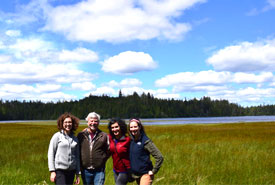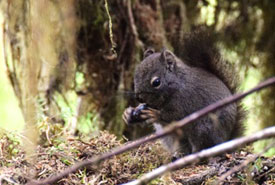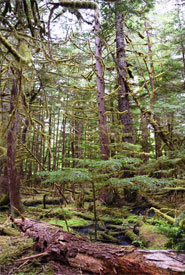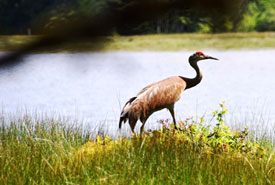Kumdis River Conservation Area
Due to the elevated wildfire risk across British Columbia, some of NCC’s conservation areas are currently closed to public access. Please check our Current Fire Closures page for more information.

NCC's BC regional staff at Kumdis River Conservation Area (Photo by NCC)
The Kumdis River Conservation Area was the Nature Conservancy of Canada's (NCC's) first land acquisition on Haida Gwaii. Located on Graham Island, one of Haida Gwaii's two main islands, this 58-hectare (144-acre) expanse of forest and wetland lies just east of the town of Port Clements. NCC purchased the Kumdis River property in 2008 from Weyerhaeuser Co.
The conservation area straddles the Kumdis River as it flows into the Kumdis Slough, a large intertidal wetland in Masset Inlet. Many waterfowl, fish and invertebrates, both migrating and resident, give this area high ecological importance.
Much of the conservation area is estuary; a transition area where the fresh water from the river mingles with the salty ocean tides. Estuarine ecosystems are particularly vulnerable to disturbances like logging, which is one of the main economic activities on Haida Gwaii. Since estuaries are relatively rare in BC, protection of such complex and dynamic ecosystems is crucial in ensuring habitat for the diverse species who live here.

A squirrel at Kumdis River Conservation Area (Photo by NCC)
Building community partnerships
The Kumdis River Conservation Area is on the traditional territory of the Haida Nation. The Haida have identified the Kumdis River as a priority for conservation within their land use plan. The diversity of interest groups, the strong cultural history and the beautiful natural areas make Haida Gwaii unique. NCC is excited to further our relationships with local communities in this truly special place.
Key species

Kumdis old-growth forest (Photo by NCC)
Trees
Giant sitka spruce and western red cedar are among the trees found on the Kumdis River Conservation Area. These iconic trees served historically as building and weaving material, and as a source for food and medicine for the Haida. Tree scars from traditional uses are still visible today. The presence of old, large trees in this ecosystem contributes to the structural and ecological strength of the area, and provides habitat for many birds.

A sandhill crane in the Kumdis estuary. (Photo by NCC)
Sandhill cranes
Known for their distinctive call and exuberant courtship dancing, the sandhill crane's uniqueness holds intrinsic value. On the Kumdis River Conservation Area, the grassy edges of the estuary near the forest's edge provide an ideal nesting environment for these birds.
American marten, peregrine falcon, bald eagle, trumpeter swan and great blue heron also frequent the area.
Salmon
The Kumdis River supports small populations of coho, pink and chinook salmon. Protection of the Kumdis Estuary provides rearing habitat that these salmon need in order to survive. Cutthroat trout, steelhead trout and Dolly Varden char are also found in Haida Gwaii's waters.
Mapping the trails
Several trails wind through the conservation area, believed to have been created by forestry companies. As NCC develops a stewardship plan for Kumdis, we will use the data gathered by geographical information systems to create a map of these trails to facilitate walking and hiking in the area.




